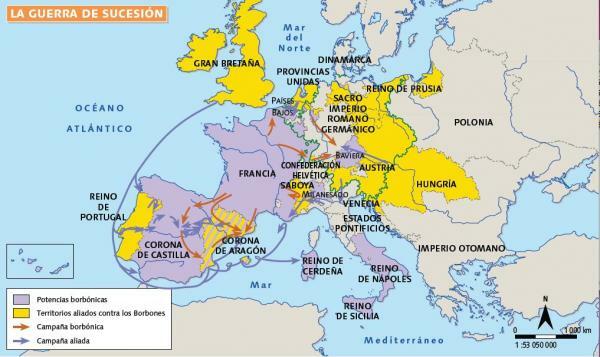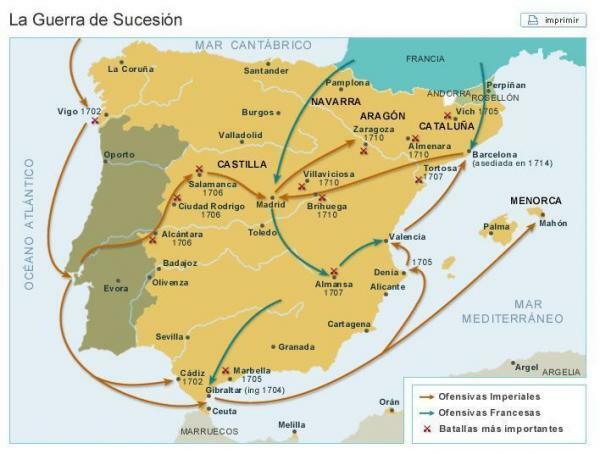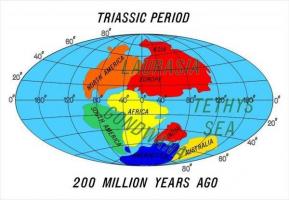War of the Spanish Succession

Image: World History and Economy
Spain in the sixteenth century was one of the main European powers encompassing a wide territory starting from Spain, the colonies of America, Milan, Naples, Sicily, Sardinia and the Netherlands. However at the end of the seventeenth century France was the European power while Spain during the reign of Carlos II of Habsburg goes into decline to which is added that, after his death, he left the throne without heir.
This historical fact ended up causing a dynastic war that we know as the War of the Spanish Succession and that lasted between the years 1701 to 1713 with the signing of the Treaty of Utrecht. Next in this lesson from a PROFESSOR we will delve into this key historical conflict not only in the history of Spain but also in that of Europe. Keep reading and you will be able to read a brief summary of the War of the Spanish Succession, an event that marked the course of our contemporary time.
We start this brief summary of the War of the Spanish Succession
starting from the death of Carlos II who died on November 1, 1700. With her, left a throne without heirs reason why two were the candidates chosen for the succession of the throne, both married with sisters of Carlos II.- On one side was Louis XIV King of France of the Bourbon house whose intention was to seize the throne so that it would be occupied by Felipe, his grandson, Duke of Anjou.
- On the other hand, Leopold I, Austrian emperor who also longed for the crown for his son Carlos.
The testament of Charles II appointed as king the grandson of King Louis XIV who ascended to the throne as Felipe V of Bourbon receiving all the Spanish possessions and agreeing not to unite France and Spain in a single crown.
Leopold, along with other European countries, objected since they did not trust this succession since they feared that if the kingdoms of Spain and France were united, a very powerful state would be formed.
Now that we have the background, let's dive right into the brief summary of the War of Succession. From this moment, the powers dispute the crown causing a war between Spain and Europe.
As far as Europe is concerned, we find that on the side of Philip V is the France of his grandfather Louis XIV, while on the side of Archduke Charles, there are countries like England, Holland, the German princes and of course his brother Joseph I of Austria. All these countries formed the Grand Alliance of the Hague in 1701 which was later joined by Portugal and Savoy in 1703 to prevent the union of the crown Spanish and French and all those territories belonging to Spain were distributed between these powers.
A war that turned out to be detrimental to the Bourbon troops (except in the Peninsula) in the European framework. The first clashes took place in Italy (1702) between the Austrian and Franco-Spanish empires, which could take the Duchy of Savoy at the same time that England was occupying Gibraltar on the Peninsula. In 1706 after the Battles of Ramillies Y Turin, Spain abandoned her dominion in Flanders and Milan. In 1707 the English and Dutch troops took over Sardinia and Menorca among others.
But the war of succession was not only European but also a civil war. Spain was divided into two fronts, on the one hand the kingdoms of the old crown of Aragon, that is, Aragon, Catalonia, Valencia and Mallorca declared themselves supporters of the archduke who decided to respect his old charters and privileges. The rest of Spain was in favor of the new Bourbon dynasty of Felipe V, that is, the crown of Castile and Navarre. The victory in the final Battle of Almansa (1707) opens the way to Valencia and Aragon for the Bourbon troops, the defeated kingdoms lose their privileges and are replaced by the current laws of Castile.
The year 1711 turns out to be decisive for the contest after the death in Vienna of José I Emperor of Austria, his successor is precisely Carlos, the enemy of Felipe V who rises to the throne as Charles VI of Austria who also has an important empire with a large presence in Spain since the imperial troops still dominated part of Catalonia and the Balearic Islands.
England, which until then had fought for the crowns of Spain and France not to be linked, at this moment realized that if the conflict continued both empires this time Spain and Austria would be the linked powers and in this situation decided to negotiate the peace.
In this other lesson from a TEACHER we discover a brief summary of the Crown of Castile and Aragon so that you understand how the territory was distributed.

Image: World History and Economy
Meanwhile, a war-weary Europe is sending emissaries to the Dutch city of Utrecht in order to lay the foundations for lasting peace. In the Treaty of Utrecht 1713 saw the beginning of the preponderance of England and the decline of France, as shown by England that stayed with Gibraltar and Menorca, the African slave trade and the possibility of trading with America Spanish.
Spain with France in decline must hand over to the Austrian empire the strongholds that it still conserved in the Low Countries, as well as the Milanesado, Tuscany, Naples, Sicily and Sardinia, the colony of Sacramento is returned to Portugal, which in 1750 was conquered by Spain, all in exchange for the recognition of the European powers. definitely to Felipe V as King of Spain.


